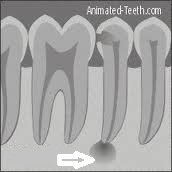X-rays are extremely important in dentistry to provide early detection of cavities and gum disease. However, there are many other uses. Since x-rays provide an image of what is inside the body, it can be used to see tumors and cysts that would otherwise go undetected. Early detection of tumors can be life-saving. Even though cysts, which are fluid-filled sacs, are not cancerous, they can expand and cause damage to bone. By periodically x-raying cysts, your dentist can see if it is beginning to grow and time surgical removal appropriately.
X-rays can also be used to detect dead nerves in teeth. Although x-rays cannot provide an image of soft tissue, once the dead nerve has caused damage to the bone surrounding the apex, or tip, of the root, it can be spotted on an x-ray film. X-rays can also be used in orthodontics to relate the upper and lower jaws to the rest of the skull. This can give an important insight on how to proceed with treatment. They can also be used to track growth and development in children. Another use of x-rays is to view implant placement to make sure that it is lined up properly during the surgery. They can also be helpful in checking the fit of crown margins. It is very important that the margin, or edge, of a crown meet the tooth surface perfectly. X-rays can see whether the margin is too short, too long, or open. Since these margins are usually tucked under the gums, x-rays provide a very useful adjunct to proper placement. As you can see, x-rays in dentistry are not just for checking cavities.








